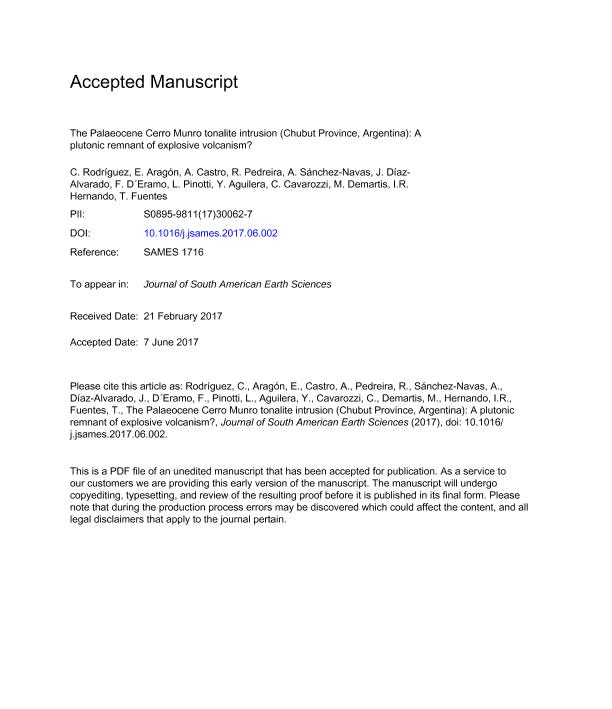Artículo
The Palaeocene Cerro Munro tonalite intrusion (Chubut Province, Argentina): A plutonic remnant of explosive volcanism?
Rodríguez, C.; Aragon, Eugenio ; Castro, A.; Pedreira, R.; Sánchez-Navas, A.; Díaz-Alvarado, J.; D´Eramo, Fernando; Pinotti, Lucio Pedro
; Castro, A.; Pedreira, R.; Sánchez-Navas, A.; Díaz-Alvarado, J.; D´Eramo, Fernando; Pinotti, Lucio Pedro ; Aguilera, Y.; Cavarozzi, Claudia Ernestina
; Aguilera, Y.; Cavarozzi, Claudia Ernestina ; Demartis, Manuel
; Demartis, Manuel ; Hernando, Irene Raquel
; Hernando, Irene Raquel ; Fuentes, Tomás Gregorio
; Fuentes, Tomás Gregorio
 ; Castro, A.; Pedreira, R.; Sánchez-Navas, A.; Díaz-Alvarado, J.; D´Eramo, Fernando; Pinotti, Lucio Pedro
; Castro, A.; Pedreira, R.; Sánchez-Navas, A.; Díaz-Alvarado, J.; D´Eramo, Fernando; Pinotti, Lucio Pedro ; Aguilera, Y.; Cavarozzi, Claudia Ernestina
; Aguilera, Y.; Cavarozzi, Claudia Ernestina ; Demartis, Manuel
; Demartis, Manuel ; Hernando, Irene Raquel
; Hernando, Irene Raquel ; Fuentes, Tomás Gregorio
; Fuentes, Tomás Gregorio
Fecha de publicación:
10/2017
Editorial:
Pergamon-Elsevier Science Ltd
Revista:
Journal of South American Earth Sciences
ISSN:
0895-9811
Idioma:
Inglés
Tipo de recurso:
Artículo publicado
Clasificación temática:
Resumen
The Cerro Munro sub-volcanic intrusion is emplaced in the back-arc (400 km from the trench) as small sub-circular tonalite-granodiorite plutons with abundant radial porphyritic dikes. U-Pb zircon SHRIMP data give an age of crystallization of 57 Ma ± 1.4 Ma. It is located to the east of the North Patagonian Batholith (NPB) that shows a protracted and episodic magmatic history from Cretaceous to Miocene time. The NPB Palaeogene episode is characterized by the lack of magmatic activity at the arc axis, as small plutonic emplacements move to the fore-arc and back-arc. This Palaeogene tectono-magmatic episode is ruled by the detachment of the Aluk plate during the Aluk-Farallon-SAM triple junction, active at that time along northern Patagonia active margin, changing the Cretaceous ?NPB orogenic? setting to a Palaeogene ?Munro transitional? tectono-magmatic setting. Near the contacts, the tonalite contains abundant enclaves of igneous appearance and variable size from several cm to dm, described as autoliths. The study of autoliths and host tonalite reveals interesting results on the processes of fractionation in a thermally zoned magma chamber. Autoliths, and in a large extent the host tonalite, represent disguised cumulates from which a hydrous silicic liquid was extracted. Barometry calculations from mineral chemistry in both autoliths and tonalites record a shallow pressure of emplacement of 0.5 kbar. Rhyolite-dacite flows and ignimbrites, surrounding the northern contact of the Cerro Munro tonalite, may represent the exsolved liquid from the plutonic cumulates. The study by cathodoluminiscence and electron backscattered diffraction techniques from a rhyolite-hosted quartz supports this protracted history of the Cerro Munro magma chamber.
Archivos asociados
Licencia
Identificadores
Colecciones
Articulos(CCT - CORDOBA)
Articulos de CTRO.CIENTIFICO TECNOL.CONICET - CORDOBA
Articulos de CTRO.CIENTIFICO TECNOL.CONICET - CORDOBA
Articulos(CIG)
Articulos de CENTRO DE INVEST.GEOLOGICAS (I)
Articulos de CENTRO DE INVEST.GEOLOGICAS (I)
Citación
Rodríguez, C.; Aragon, Eugenio; Castro, A.; Pedreira, R.; Sánchez-Navas, A.; et al.; The Palaeocene Cerro Munro tonalite intrusion (Chubut Province, Argentina): A plutonic remnant of explosive volcanism?; Pergamon-Elsevier Science Ltd; Journal of South American Earth Sciences; 78; 10-2017; 38-60
Compartir
Altmétricas



